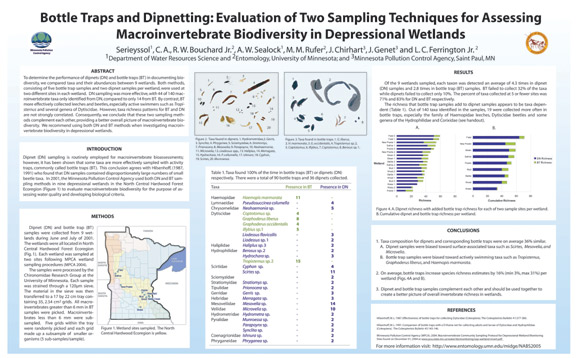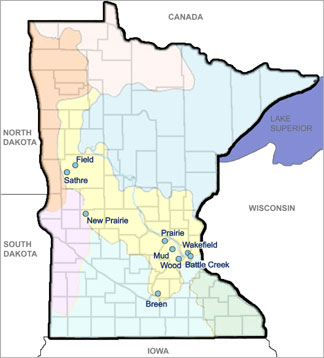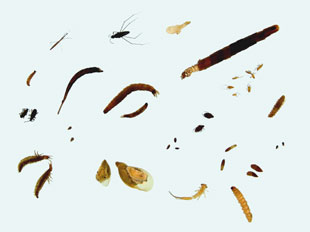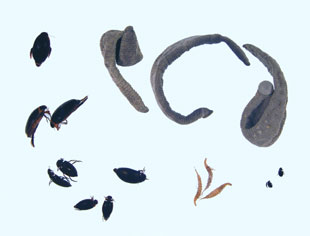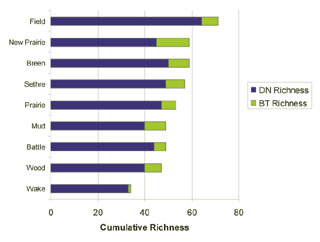Bottle Traps and Dipnetting: Evaluation of Two Sampling Techniques for Assessing Macroinvertebrate Biodiversity in Depressional Wetlands
Serieyssol (1), C. A., R. W. Bouchard Jr. (2), A. W. Sealock (1), M. M. Rufer (2), J. Chirhart (3), J. Genet (3) and L. C. Ferrington Jr. (2).
1 Department of Water Resources Science, University of Minnesota
2 Entomology, University of Minnesota
3 Minnesota Pollution Control Agency, Saint Paul, MN
Abstract
To determine the performance of dipnets (DN) and bottle traps (BT) in documenting biodiversity, we compared taxa and their abundances between 9 wetlands. Both methods, consisting of five bottle trap samples and two dipnet samples per wetland, were used at two different sites in each wetland. DN sampling was more effective, with 44 of 140 macroinvertebrate taxa only identified from DN, compared to only 14 from BT. By contrast, BT more effectively collected leeches and beetles, especially active swimmers such as Tropisternus and several genera of Dytiscidae. However, taxa richness patterns for BT and DN are not strongly correlated. Consequently, we conclude that these two sampling methods complement each other, providing a better overall picture of macroinvertebrate biodiversity. We recommend using both DN and BT methods when investigating macroinvertebrate biodiversity in depressional wetlands.
Introduction
Dipnet (DN) sampling is routinely employed for macroinvertebrate bioassessments; however, it has been shown that some taxa are more effectively sampled with activity traps, commonly called bottle traps (BT). This conclusion agrees with Hilsenhoff, (1987, 1991) who found that DN samples contained disproportionately large numbers of small beetle taxa. In 2001, the Minnesota Pollution Control Agency used both DN and BT sampling methods in nine depressional wetlands in the North Central Hardwood Forest Ecoregion (Figure 1) to evaluate macroinvertebrate biodiversity for the purpose of assessing water quality and developing biological criteria.
Methods
Dipnet (DN) and bottle trap (BT) samples were collected from 9 wetlands during June and July of 2001. The wetlands were all located in North Central Hardwood Forest Ecoregion (Fig. 1). Each wetland was sampled at two sites following MPCA wetland sampling procedures (MPCA 2004).
The samples were processed by the Chironomidae Research Group at the University of Minnesota. Each sample was strained through a 120µm sieve. The material in the sieve was then transferred to a 17 by 22 cm tray containing 35, 2.54 cm2 grids. All macroinvertebrates greater than 6 mm in BT samples were picked. Macroinvertebrates less than 6 mm were subsampled. Five grids within the tray were randomly picked and each grid made up a subsample of smaller organisms (5 sub-samples/sample).
Bottle trap design.
Figure 1. Wetland sites sampled. The North Central Hardwood Ecoregion is yellow.
Figure 2. Taxa found in dipnets. 1. Hydrometridae, 2. Gerris, 3. Synclita, 4. Phryganea, 5. Sciomyzidae, 6. Stratiomys, 7. Prionocera, 8. Mesovelia, 9. Parapoynx, 10. Neohaemonia, 11. Microvelia, 12. Liodessus spp., 13. Haliplus, 14. Merragata, 15. Hydrochara, 16. P. collumella, 17. Ishnura, 18. Cyphon, 19. Scirtes, 20. Munroessa.
Figure. 3. Taxa found in bottle traps. 1. G. liberus, 2. H. marmorata, 3. G. occidentalis, 4. Tropisternus sp. 2, 5. Coptotomus, 6. Illybius, 7. Coptotomus, 8. Berosus sp. 1.
Table 1. Taxa found 100% of the time in bottle traps (BT) or dipnets (DN) respectively. There were a total of 90 bottle traps and 36 dipnets collected.
| Taxa | Presence in Bottle Traps | Presence in Dipnets | |
|---|---|---|---|
| Haemopidae | Haemopis marmorata | 11 | - |
| Lymnaeidae | Pseudosuccinea columella | - | 4 |
| Chrysomelidae | Neohaemonia sp. | - | 5 |
| Dytiscidae | Coptotomus sp. | 4 | - |
| Graphoderus liberus | 8 | - | |
| Graphoderus occidentalis | 4 | - | |
| Illybius sp.1 | 5 | - | |
| Liodessus flavicollis | - | 3 | |
| Liodessus sp. 1 | - | 2 | |
| Haliplidae | Haliplus sp. 3 | - | 2 |
| Hydrophilidae | Berosus sp. 2 | - | 2 |
| Hydrochara sp. | - | 3 | |
| Tropisternus sp. 2 | 15 | - | |
| Scirtidae | Cyphon sp. | - | 4 |
| Scirtes sp. | - | 11 | |
| Sciomyzidae | 2 | - | |
|
Stratiomyidae |
Stratiomys sp. |
- | 2 |
| Tipulidae | Prionocera sp. | - | 2 |
| Gerridae | Gerris sp. | - | 3 |
| Hebridae | Merragata sp. | - | 3 |
| Mesoveliidae | Mesovelia sp. | - | 14 |
| Veliidae | Microvelia sp. | - | 10 |
| Hydrometridae | Hydrometra sp. | - | 2 |
| Pyralidae | Munroessa sp. | - | 2 |
| Parapoynx sp. | - | 2 | |
| Synclita sp. | - | 2 | |
| Coenagrionidae | Ishnura sp. | - | 2 |
| Phryganeidae | Phryganea sp. | - | 2 |
Results
Of the 9 wetlands sampled, each taxon was detected an average of 4.3 times in dipnet (DN) samples and 2.8 times in bottle trap (BT) samples. BT failed to collect 32% of the taxa while dipnets failed to collect only 10%. The percent of taxa collected at 5 or fewer sites was 71% and 83% for DN and BT respectively.
The richness that bottle trap samples add to dipnet samples appears to be taxa dependent (Table 1). Out of 140 taxa identified in the samples, 19 were collected more often in bottle traps, especially the family of Haemopidae leeches, Dytiscidae beetles and some genera of the Hydrophilidae and Corixidae (see handout).
Figure 4. A. Dipnet richness with added bottle trap richness for each of two sample sites per wetland.
B. Cumulative dipnet and bottle trap richness per wetland.
References
Hilsenhoff, W. L. 1987. Effectiveness of bottle traps for collecting Dytscidae (Coleoptera). The Coleopterists Bulletin 41:377-380.
Hilsenhoff, W. L. 1991. Comparison of bottle traps with a D-frame net for collecting adults and larvae of Dytiscidae and Hydrophilidae (Coleoptera). The Coleopterists Bulletin 45:143-146.
Minnesota Pollution Control Agency (MPCA). 2004. Macroinvertebrate Community Sampling Protocol for Depressional Wetland Monitoring Sites found on December 01, 2004 at www.pca.state.mn.us/water/biomonitoring/sop-wetland-invert.pdf
Conclusions
- Taxa composition for dipnets and corresponding bottle traps were on average 36% similar.
- Dipnet samples were biased toward surface-associated taxa such as Scirtes, Mesovelia, and Microvelia.
- Bottle trap samples were biased toward actively swimming taxa such as Tropisternus, Graphoderus liberus, and Haemopis marmorata.
- On average, bottle traps increase species richness estimates by 16% (min 3%, max 31%) per wetland (Figs. 4A and B).
- Dipnet and bottle trap samples complement each other and should be used together to create a better picture of overall invertebrate richness in wetlands.
